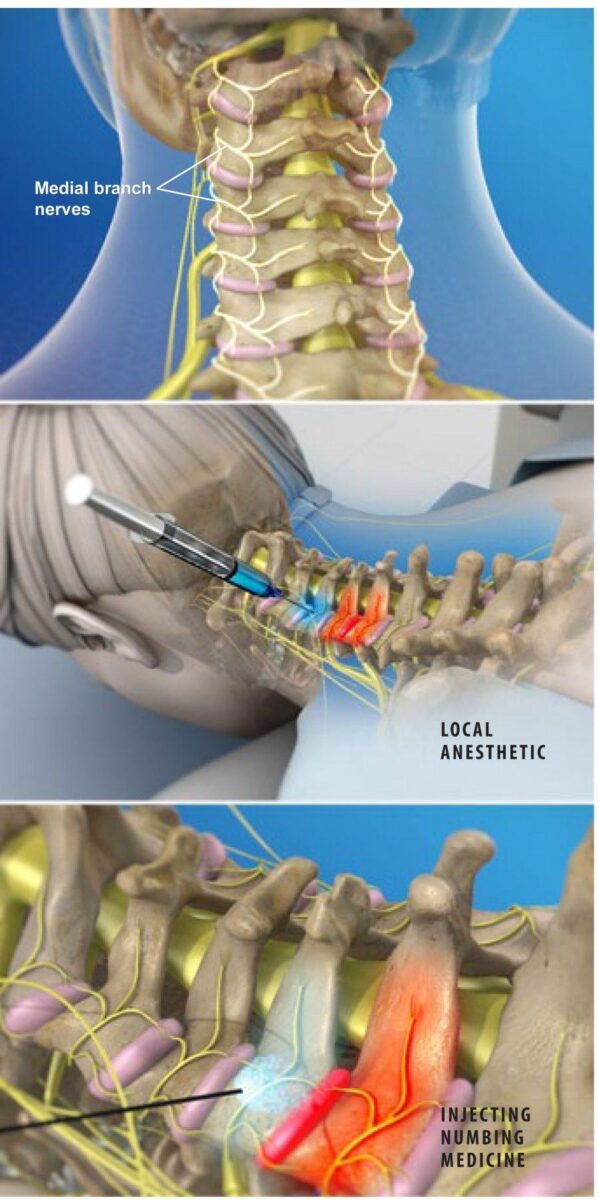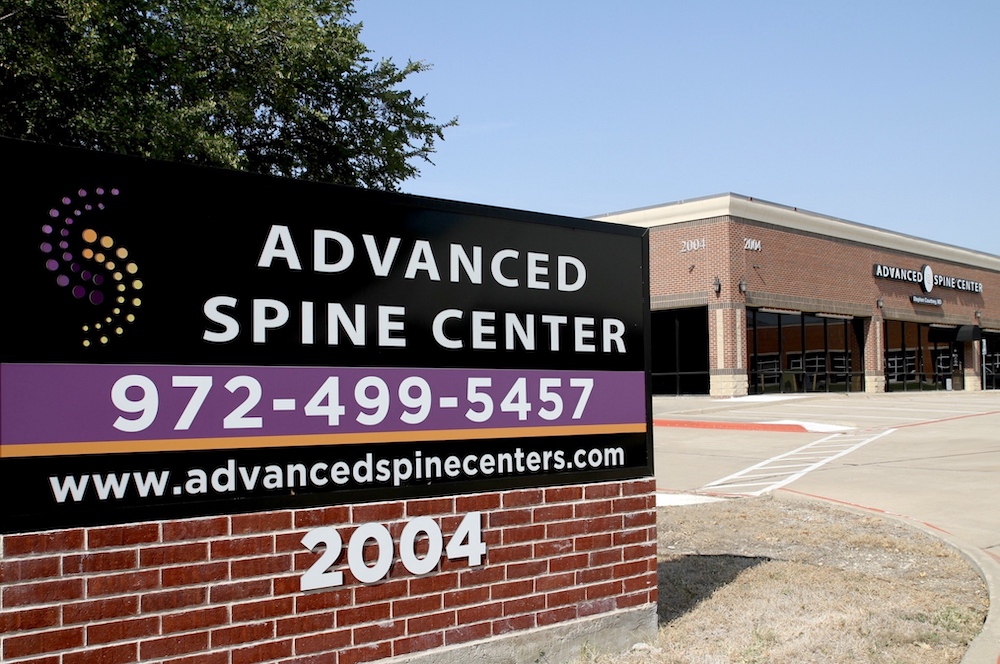Specialties
Table of Contents

At the Advanced Spine Center, we pride ourselves on being the premier destination for orthopedic spine care in Plano, TX. If you’re experiencing chronic neck pain that radiates into your shoulders or arms, a cervical medial branch block might be the solution you’ve been searching for.
Our team of expert spine surgeons specializes in advanced techniques like cervical medial branch blocks to provide targeted pain relief and improve your quality of life. Learn more about this minimally invasive procedure and how it could alleviate your discomfort today. To schedule an appointment, please call our office at 972-499-5457 today.
What Is a Cervical Medial Branch Block?
A cervical medial branch block is an injection of numbing medicine that bathes the medial branch nerves. These nerves are attached to the facet joints of the spine. Disease or injury of these joints can cause pain in the medial branch nerves. This pain may travel through the neck, shoulders, upper back, and head. A medial branch block can help your physician find the source of your pain. It may also provide temporary pain relief.
During a cervical medial branch block, a local anesthetic and anti-inflammatory medication are injected near the medial branch nerves that supply sensation to the facet joints. By blocking the transmission of pain signals along these nerves, the procedure can provide temporary relief and help pinpoint the source of the pain.
Cervical Medial Branch Blocks vs Facet Injections
Cervical medial branch blocks and facet injections are both procedures used to diagnose and treat neck pain originating from the facet joints of the spine. However, they target different structures and serve slightly different purposes.
Cervical medial branch blocks specifically target the medial branch nerves that transmit pain signals from the facet joints to the brain. They are primarily used as a diagnostic tool to identify whether the facet joints are the source of the pain. If the block provides significant pain relief, it suggests that the facet joints are indeed the cause of the discomfort. This information helps guide further treatment decisions, such as radiofrequency ablation or other interventions.
Cervical facet joint injections, on the other hand, involve the direct injection of anesthetic and corticosteroid medication into the facet joints themselves. This procedure aims to provide both diagnostic information and therapeutic relief by reducing inflammation and alleviating pain directly within the affected joints. Facet injections can be used both diagnostically to confirm the facet joints as the source of pain and therapeutically to provide longer-lasting relief by reducing inflammation and irritation within the joints.
Diagnostic Cervical Medial Branch Block
A cervical medial branch block is used as a diagnostic tool to identify the facet joints as the source of pain in the cervical spine. During the procedure, a local anesthetic and anti-inflammatory medication are injected near the medial branch nerves that supply sensation to the facet joints. If the block provides significant pain relief, it indicates that the facet joints are likely the source of the discomfort. This information helps guide further treatment decisions
What Are Cervical Medial Branch Block Injections Used to Treat?
Cervical medial branch block injections are primarily used to diagnose and treat chronic neck pain caused by facet joint dysfunction in the cervical spine. They can also help with head, upper back, and shoulder pain.
By injecting a local anesthetic and anti-inflammatory medication near the medial branch nerves that transmit pain signals from the facet joints, cervical medial branch blocks can provide temporary pain relief and help pinpoint the source of the discomfort. Then, other treatment methods may be employed to achieve long-lasting relief for the patient.
Cervical Medial Branch Block Procedure
The cervical medial branch nerve block procedure is typically performed as an outpatient procedure. It involves several steps to accurately diagnose and treat neck pain originating from the facet joints of the cervical spine.

Preparation
First, the patient will be positioned comfortably on an examination table, usually lying face down. The area to be injected, typically the back of the neck, will be cleansed and sterilized to reduce the risk of infection.
In preparation for the procedure, the physician injects local anesthetic. This numbs the skin and tissue around the level or levels that will be injected.
Inserting the Needle
Next, the physician pushes a thin needle through the numbed tissue. The physician uses an x-ray device called a fluoroscope to see the needle in your body. The needle is carefully guided toward the medial branch nerves. Contrast dye is injected through the needle to confirm that it is positioned correctly.
Injection
When the needle is in place, the physician injects numbing medicine onto the nerves. This medicine temporarily numbs sensation. If this area is the source of your pain, you will experience immediate pain relief. More than one level of the spine may need to be injected.
End of Procedure
When the procedure is complete, you will be monitored for a brief time and then allowed to go home. A medial branch block may relieve your pain for the next few hours. You may be asked to keep track of your pain level as the medicine wears off. If the block was successful, your physician may recommend a procedure called radiofrequency ablation. This can provide more permanent pain relief.
What Is the Next Step After a Cervical Medial Branch Block?
After a cervical medial branch block, the next step depends on the outcome of the procedure and the individual patient’s response to treatment. If the cervical medial branch block provides significant relief from chronic pain, it confirms that the facet joints are likely the source of the discomfort. In this case, the next step may involve further interventions targeted at providing longer-lasting pain relief and improving the patient’s quality of life.
One common next step is a procedure called radiofrequency ablation (RFA), also known as radiofrequency neurotomy of the cervical facets. It involves using heat generated by radiofrequency waves to selectively destroy the medial branch nerves responsible for transmitting pain signals from the facet joints. Interrupting the transmission of these pain signals can provide more sustained relief from neck pain compared to the temporary relief provided by the cervical medial branch block.
It’s important for patients to discuss their treatment options with their healthcare provider and weigh the potential benefits and risks of each intervention. By working closely with our medical team, patients can make informed decisions about their care and take proactive steps toward managing their neck pain effectively.
Cervical Medial Branch Block Recovery Time
The recovery time following a cervical medial branch block is typically minimal. Since it’s a minimally invasive outpatient procedure, most patients can resume their normal activities shortly after the injection. Some individuals may experience mild soreness or discomfort at the injection site, which usually resolves within a day or two.
It’s common for patients to feel immediate pain relief following the procedure, thanks to the local anesthetic used during the injection. However, the duration of pain relief can vary from person to person. While some individuals may experience significant and prolonged relief, others may find that the effects wear off after a few hours or days.
In terms of activity restrictions, patients are usually advised to avoid strenuous activities, heavy lifting, or vigorous exercise for a day or two following the procedure. This allows the body time to recover and reduces the risk of aggravating the injection site.
Cervical Medial Branch Block Side Effects
While cervical medial branch blocks are generally safe and well-tolerated, like any medical procedure, they carry a risk of potential side effects and complications.
Some possible side effects include the following.
- Pain at the injection site
- Temporary numbness or weakness
- Allergic reactions
- Infection
- Nerve damage
- Bleeding or bruising
- Chronic spinal pain
- Spinal cord injuries
It’s important for patients to discuss potential side effects and outcomes with their doctor before undergoing the procedure.
How Long Does a Cervical Medial Branch Block Last?
The duration of pain relief from cervical medial branch nerve blocks can vary from patient to patient. Generally, the relief is only intended to last from 8 to 24 hours. It is a form of short-term pain relief that helps diagnose the true source of pain. Then, more long-lasting relief can come from more in-depth treatments.
What If a Cervical Medial Branch Block Doesn’t Work?
If a cervical medial branch block doesn’t provide the expected pain relief, it may indicate several possibilities. First, it could indicate an incorrect diagnosis. While cervical medial branch blocks are commonly used to diagnose cervical facet pain, it’s possible that the source of the pain may be different.
It could also indicate an incomplete nerve block. The injection may not have effectively blocked the targeted medial branch nerves, leading to inadequate pain relief. Factors such as inaccurate needle placement or inadequate medication delivery can contribute to this issue.
Lastly, it could indicate other underlying factors. Other factors such as inflammation, muscle spasms, nerve compression, or psychological factors may contribute to ongoing neck pain, independent of facet joint involvement.
Why Is My Pain Worse After a Cervical Medial Branch Block?
Experiencing increased pain after a cervical medial branch block, although uncommon, can happen for several reasons. Many patients enjoy significant pain relief after these injections, but it is possible to have worse pain afterward. Some potential reasons why patients may experience worse pain include the following.
- Initial reactions to the injection
- Local reactions to the medication
- Progression of the underlying condition
- Incomplete nerve block
- Rare complications, such as infection, nerve damage, or allergic reactions
Call the Advanced Spine Center for Cervical Medial Branch Blocks in Plano, TX
At the Advanced Spine Center in Plano, TX, we understand the debilitating impact that neck pain can have on your daily life. Our team of expert spine surgeons is dedicated to providing comprehensive care and innovative solutions to help you find relief. If you’re suffering from chronic neck pain, a cervical medial branch block may be the first step toward regaining your mobility and quality of life.
Our experienced specialists utilize state-of-the-art techniques and advanced technology to perform these procedures safely and effectively. Contact us today to schedule a consultation and take the first step towards a pain-free future.


